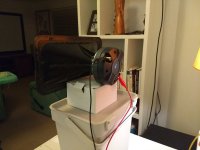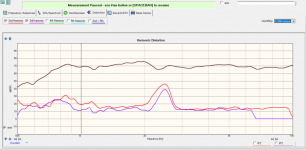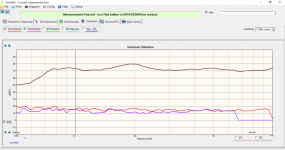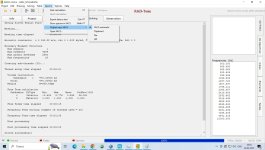Could be moved to its own or the Peerless by Tymphany DFM-2535R00-08 group buy thread?BTW, should this discussion be split off to its own thread, to keep this thread focused on mabat's work rather than a specific driver?
Mazza,Testing this....
View attachment 1439482
I got this...
View attachment 1439480
After disassembling and then running some masking tape around the voice coil gap to see if any manufacturing swarf might have been interfering I got this:
View attachment 1439479
Maybe that might help here? Good luck!
Just opened up the driver again. Nothing visible in the gap, running tape around pulled out nothing, and on reassembly I got the same response and distortion. Good thought, but no help in this case.
Bill
If you got the same response and distortion, would that indicate that diaphragm centering is consistent? So perhaps the diaphragm itself is bad rather than any design problem?
454,
That's my sense, yes. There is no play to recenter the 'phragm anyway. Rotating it 180 degrees made no difference.
The question for me now is, how bad is it? I have been playing with the miniDSP, pushing the xover point lower. Here's a quick shot at an 800 Hz LR4 in REW' EQ tab (one highpass biquad, 636Hz, Q=0.31, one peak cut, and a HF shelf boost, no attention to the 1 kHz dip) for the 'bad' driver:

And how it measured:

Distortion at 96 dB (maybe 97), SPL and relative:


The THD trace (not shown) entirely tracks the 2nd harmonic.
This is an inexpensive 1" CD running down to 800 Hz, pushing the lower limits of the horn's design, and playing at what would be peak volume in my small room. The 2nd harmonic trace looks odd, but I don't know how mad I can be at it. I expect the mfg. to say it is within spec. Would this be audibly flawed? Bad enough to bail and throw $$$ at more capable drivers? Good enough to justify buying filament and plans to print a pair of A400's or A460's and building boxes for my 15" woofers?
That's my sense, yes. There is no play to recenter the 'phragm anyway. Rotating it 180 degrees made no difference.
The question for me now is, how bad is it? I have been playing with the miniDSP, pushing the xover point lower. Here's a quick shot at an 800 Hz LR4 in REW' EQ tab (one highpass biquad, 636Hz, Q=0.31, one peak cut, and a HF shelf boost, no attention to the 1 kHz dip) for the 'bad' driver:
And how it measured:
Distortion at 96 dB (maybe 97), SPL and relative:
The THD trace (not shown) entirely tracks the 2nd harmonic.
This is an inexpensive 1" CD running down to 800 Hz, pushing the lower limits of the horn's design, and playing at what would be peak volume in my small room. The 2nd harmonic trace looks odd, but I don't know how mad I can be at it. I expect the mfg. to say it is within spec. Would this be audibly flawed? Bad enough to bail and throw $$$ at more capable drivers? Good enough to justify buying filament and plans to print a pair of A400's or A460's and building boxes for my 15" woofers?
H2 is significantly elevated when comparing it to these measurements, though one's got to remember it is on a different horn: https://www.diyaudio.com/community/...y-tympahny-dfm-2535r00-08.415988/post-7757146The question for me now is, how bad is it?
It is second harmonics, and I read it is mostly inaudible. H3, surpinsingly, doesn't differ a lot.Would this be audibly flawed?
Probably yes. H2 appears to be compromised between 1kHz and 8 kHz, "otherwise" the driver performs similarly.Good enough to justify buying filament and plans to print a pair of A400's or A460's and building boxes for my 15" woofers?
Overlay graph of 2nd harmonic between the two drivers at 96 dB (back to the original data with no filters applied). It's really only worse over about an octave.

I suppose my next step should be to swap the diaphragms between the housings. Maybe tomorrow.
I suppose my next step should be to swap the diaphragms between the housings. Maybe tomorrow.
I don't know what kind of mic were used, but most electret measurement mics like EMM-6 or ECM-8000 have elevated H2 due to suboptimal preamp (more precisely, single FET inside the capsule).H2 is significantly elevated when comparing it to these measurements
No pics today, but I did confirm that the distortion behavior follows the diaphragm when swapped into the other housing. No surprise I'm sure.
Hi guys. Can you help me? After modeling the ATN waveguide (using the latest version) and successfully calculating abec3, I can't see the results of VACS. I use ABEC_Demo_v360b07_NoInstaller or ABEC_Pro_v360b07 and automatic exit to VACS. The result is the same - VACS does not open. I use the code for the ATH from post №6628. I will be grateful for any help.
Attachments
You haven't calculated the Spectra so there is nothing to show in VACS, spectrum calculation is separate to solving unless you choose the option to run all calculations. In your screenshot you can select the start calculation option, the spectra will go green and open in VACS.
I just had one of the larger Tritonia-M models printed through Craft Cloud as a single piece in PETG. The picture doesn't do the size justice. I am going to attempt active crossovers with the JRiver suite of tools. Once my DH450H-16 drivers come in. I have quite a bit of filling/sanding to do before it's finished. For the price, I wasn't overly impressed with the print quality, so I ended up ordering the new Bambu H2D printer for future prints. It can easily print these with it's 350x320 print bed.

The Stuarts (as I've been calling them because they remind me of the cyclopse Minion of the same name) are done, hooked up, and singing. @mabat - your horn geometry sounds amazing, and that combined with the rear chamber from Joseph Crow got the SB Audience 65CDN-T down to 500 Hz before it really began to drop off. The horn is crossed over at 600 Hz to a Faital Pro 15PR400, actively driven with a 2A3 amp for the horn and a pair of the small but mighty Fosi V3 monoblocks for the woofer. It sounds amazing, loud, and dynamic and I couldn't be happier. Thank you to everyone on this forum for all the advice and knowledge, it is really amazing how much collective intelligence is out there that people are willing to share if you just ask. You are all extremely generous with your talents and I am SO GRATEFUL for it. Thank you!
Attachments
anyone had success making a very short horn? im looking for something i can fit into my kick panels. maybe the tritona? im not even sure what coverage would be best.
I think I've published more waveguides for cars than anyone in the world. My 'magnum opus' is over on diyma, back in 2006. Just pull up my submissions and sort by "popular"
For a car, I think there are three options:
1) The 'traditional' option is underdash horns. There are very VERY few measurements of these available, mostly because many of them perform horribly. I posted an article about this on diyaudio, called "the Homster." I am not completely opposed to underdash horns, I just wish they performed better. Their main advantage, IMHO, is that you can't see them. Not being able to see your speakers helps a LOT with imaging. Back in the 90s, car audio competitors would sometimes install center channels that weren't even plugged in, simply because when you SEE a speaker it changes your perception of where the sound is radiating from.
2) The second move conventional option is to put waveguides up on the dash. This is probably the easiest option. I did this with various Unity horns and the results were generally quite good. On the downside, they're ugly, they're always in your face. It's probably dangerous to have a fifteen pound waveguide on the dash. The depth of stage isn't great, because your dash is MUCH closer to you than the firewall of your car.
3) Kick panels have a lot of potential. You have a VERY limited number of tweeters that you can use, because getting the depth as shallow as possible makes a HUGE difference in leg room. I think you would be shocked at how loud a good neodymium soft dome can get in the right waveguide. Basically, the "old school" horns from the 90s used GIGANTIC compression drivers, because compression drivers were just HUGE back in the day. The Altecs in Richard Clark's Grand National were the size of small subwoofer. Since I assume that you're making waveguides for sound quality, not sheer SPL, you can probably get away with a neodymium soft dome in a waveguide. Those can be SUPER shallow. For instance, here's a photo of the waveguide and tweeter from a Revel speaker:
https://www.audiosciencereview.com/...revel-f208-tower-speaker-review.13192/page-12
... look fantastic. Superb form and choice of colors and materials. A work of art - congratulations!The Stuarts
//
Wow, lovely!are done, hooked up, and singing.
Very nice combination of forms, materials and colors.
I also like the sideboard very much - done by yourself I guess?
There have been several requests for removing the mounting holes of the Tritonia-M model.
If you want to integrate the waveguide into a custom baffle, there's hardly a better way than using the provided STEP model yourself. Just adapt it however you want -

The above was done in Fusion360, BTW - just click on the hole wall(s) and press Delete (the smaller holes first).
I've updated the STL package at Cults, but the STEP model is really what you want to use for any customization (integrate it in a one-piece CNCed baffle, cut out a woofer hole, whatever)...
If you want to integrate the waveguide into a custom baffle, there's hardly a better way than using the provided STEP model yourself. Just adapt it however you want -
The above was done in Fusion360, BTW - just click on the hole wall(s) and press Delete (the smaller holes first).
I've updated the STL package at Cults, but the STEP model is really what you want to use for any customization (integrate it in a one-piece CNCed baffle, cut out a woofer hole, whatever)...
Hi BillJust for fun I tried my hand at a passive filter in XSim. I didn't try to correct all of the HF rolloff, but otherwise it looks pretty flat to me. My hearing is dead above 10k anyway!
Not actually built, of course, just a first swipe at it, and no attempt at using real-world components. Ignore the second driver in the xover.
View attachment 1437993View attachment 1437992
Bill
Would you mind sharing this xsim project?
Not to derail things too much, but will Windows 11 run on either of those?
Update:
It looks like it's fairly simple to get Windows 11 running on older computers:
I assumed it was impossible, because as I understand it, Windows 11 can't boot without a TPM module. Again, I'm a Linux guy, not super familiar with the innards of Windows booting, but I understand the TPM module is a security measure required by Windows 11.
Apparently, it's possible to bypass: https://www.tomshardware.com/how-to/bypass-windows-11-tpm-requirement
If I'm not mistaken, this should ALSO apply to VMs, since the hardware features are passed through via the hypervisor.
Also, don't install Windows 11 if you can avoid it. I've never been able to find a single feature in Windows 11 that adds any valuable functionality or compatibility, and the GUI is far worse. (Why on earth did they move the Start menu? Why do I have to suffer through a sidebar full of MSN nonsense if I accidentally move my mouse too close to the edge of the left screen? Why is every other version of Windows and Star Trek good, and why is every other version of Windows and Star Trek terrible?)
1) Good: Windows 10 and Star Trek II
2) Bad: Windows 11 and Star Trek III
- Home
- Loudspeakers
- Multi-Way
- Acoustic Horn Design – The Easy Way (Ath4)





